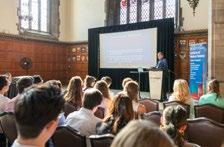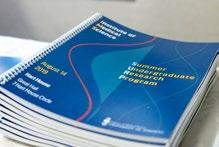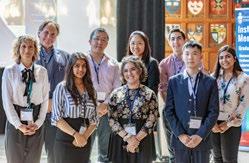
13 minute read
Past Events
by IMS Magazine
SURP Research Day 2019
A Great Day of Learning and Discovery
Advertisement

By Sonja Elsaid T he 36th Institute of Medical Science (IMS) Annual SURP (Summer Undergraduate Research Program) Research Day was held on August 14, 2019, at Hart House. SURP Research Day was the concluding event of a 12–week summer research program, bringing together undergraduate students from around the globe. This excellent program has been led for almost a decade by Dr. Vasundara Venkateswaran, Professor at the Department of Surgery and Graduate Coordinator and Director (SURP) at the IMS, University of Toronto (U of T). I had an opportunity to interview Dr. Venkateswaran about the aims and benefits of the program and how the program has evolved over the years under Dr. Venkateswaran’s guidance.
According to Dr. Venkateswaran, the primary aim of SURP is to give undergraduate science and medical students firsthand experience working at the bench and within clinical research at the U of T and its affiliated hospitals. This year nearly 100 students enrolled in the program to conduct research in the number of diverse fields of medical science, including neuroscience, cardiology, infectious diseases, rheumatology, audiology, cancer, ophthalmology, transplant medicine, and pain management. Students attending the program, benefit from the opportunity to test whether medical research is what they want to pursue before committing to a long-term graduate program. For some students, there is also an opportunity to obtain their graduate training from IMS faculty supervising their SURP project. One of the main advantages of being in the program is the opportunity to participate in weekly SURP seminars, journal clubs, and workshops. The seminars are not only rendered by IMS faculty, but by IMS graduate students who readily share their experiences with undergrads regarding graduate research, interaction with supervisors, and the skills and mindset needed to navigate both. In order to receive the SURP certificate of completion, each student is required to present either a poster or a podium presentation at the SURP Research Day. These presentations are judged by a group of IMS faculty members as well as the IMS graduate students.
Under the leadership of Dr. Venkateswaran’s the number of SURP awards that were presented at the Research Day increased 10 fold. Initially there were only 2 awards, one for the first place and a second for the honorable mention. However, Dr. Venkateswaran’s has in place 2 awards for each group of 10-12 students. Her aim of increasing the number of awards is to motivate the students to pursue research and encourage a healthy competition among the students. Furthermore, at each SURP Research Day many excellent posters and presentations are regularly delivered, so it is difficult to select 2 winners among nearly 100 students. The winners are presented books that are personally selected by Dr. Venkateswaran. These new implementations to SURP are a reflection of Dr. Venkateswaran’s generous nature and her dedication in educating both undergraduate and graduate students.
This year’s SURP Research Day commenced with a welcome note from Dr. Mingyao Liu—Director of the IMS and Professor of Surgery, Medicine, and Physiology at the Faculty of Medicine, U of T, followed by introduction of the Keynote speaker by Dr. Venkateswaran. Michelle Dubinsky, Ph.D. student at the IMS, was the Master of Ceremonies and helped coordinate the research day. Dr. Alan Kaplan delivered an excellent keynote presentation titled: “Genes or Jeans? The Etiology and Treatment of Anorexia Nervosa”. Dr. Kaplan is the Vice-Dean of the IMS, Senior Clinician/ Scientist, Chief of Research at the Center for Addiction and Mental Health, ViceChair for Research and Professor in the Department of Psychiatry at the U of T. His presentation described the latest research findings on genetic predispositions to Anorexia Nervosa and how these predispositions, in combination with psychological, socio-cultural, and environmental factors, contributed to the pathogenesis of the disorder. Dr. Kaplan’s presentation was followed by six podium presentations by students on the topics of brain injury, psoriatic arthritis, clinical trials, Chinese medicine, acute myeloid leukemia, and diabetic retinopathy.
The afternoon session included excellent poster presentations by the remaining 94 undergraduate students. I spoke to a few students about their experiences in the program. Ming Mao—a thirdyear medical student from Shandong University in China—joined the program because he was specifically interested in U of T’s cutting-edge research in epilepsy and neurodegenerative disorders. Ming enjoyed his summer research experience so much that he expressed an interest in pursuing his graduate training at the IMS after completing his medical degree. Ming’s project was on histological verification of a novel non-lesioned seizure mouse model, which he conducted under the supervision of Dr. Liang Zhang—the


Associate Professor of Neurology and an Affiliate Scientist at the Krembil Research Institute. Sandra Vijayan—a first-year medical student from Dublin, Ireland— joined the program because she wanted to get her firsthand experience in research. She worked under the supervision of Dr. Nigil Haroon—the Assistant Professor of Medicine and Rheumatology and Clinician-scientist at the Toronto Western Hospital and Krembil Research Institute. Her summer research was on ossification in ankylosing spondylitis under hypoxic conditions. Sandra described her experience as “revelational” and she was very much inspired being mentored by senior graduate students in Dr. Haroon’s lab. I also interviewed Karen Arevalo—a third-year undergraduate student from McMaster University—enrolled in the Integrated Science program. During the interview, Karen shared her struggles with getting a summer research job due to the large number of applicants interested, while there is only a limited number of summer research positions available. Being previously unsuccessful in getting the summer research position, Karen spent her summers working as a waitress. This year, Karen decided to test her luck and reach out to all potential supervisors

working in the scientific research at the U of T—near her home residence in Vaughan. She was fortunate to be recruited by Dr. Aaron Schimmer—Senior Scientist and the Director of Research Institute at the Princess Margaret Cancer Centre. Karen’s firsthand experience working in Dr. Schimmer’s lab with the animal model of acute myeloid leukemia was transformational, as after completing the 12-week program, Karen decided to pursue academic research as her longlife career. While attending the SURP program, Karen mostly enjoyed the weekly speaker seminars, interacting with the IMS graduate students and learning “the art of presenting research,” which she learned quite well, since Karen was the podium presentation winner.
Aside from Karen Arevalo’s first prize podium presentation, during the award ceremony, 11 other undergraduate students received first prizes for their excellent poster presentations. The first prize poster winners were: Roshanak Asgariroozbehani, Leon Chi, Tiffany Got, Sae Hoon (Dave) Gwun, Seung Heyck Lee, Benjamin Liu, Michael Peng, Jared Riviere, Joelle Soriano, Sandra Vijayan, and Qin Yi (Teresa) Zhu. Also, 12 other

students received honorable mentions, as they were runner-up winners in each competition category. For the first time this year, Jasmine Quigley Memorial Award was given at the SURP. The award was created to support the excellent work of an undergraduate summer student whose project was related to the topic of biotechnology as applied to neuroscience/ mental health field.
The first recipient of this award was Lara Murphy, who presented a poster titled: “Gene-drug pairing for antidepressants and antipsychotics: A review of the level of evidence using expert consensus recommendations.” The Quigley family presented the award shortly before the conclusion of the event.
After yet another successful SURP Research Day, Dr. Venkateswaran congratulated all the students on successfully completing their projects and thanked the IMS administrative staff, graduate students, judges, and sponsors who contributed to making the event possible. Overall, SURP Research Day 2019 was a great day of learning and discovery.


It was summer 2019. Across the desk sat Vasu Venkateswaran, smiling after catching me up on the current status of the Ori Rotstein Lecture in Translational Research. She looked at me and asked “Ok, given the title of the lecture, what do you want the panel discussion to be about?” The lecture title was long, daunting even, and clinically specific, but what stood out to us were the first two words: “my journey”. By Laura Best and Alexa Desimone
One of the most cliché phrases my mother imparted on me was that life is not about the destination, but the journey. As a child who followed the common progression from elementary to university, this wisdom had very little meaning. My academic life existed separately from my personal life, serving the sole purpose of getting me to my future career. Life used to function more like a checklist than a journey. Yet, somewhere along the way this changed. Unexpected obstacles and opinions made me rethink previous decisions, predetermined timelines extended and shrank, priorities shifted as new people and opportunities presented themselves. However, this is common and rarely do students embark on a linear track that leads them to their predetermined finish line without turns or hurdles. These twists and hurdles often make one stronger and more innovative. I learned that this is the journey, and that is what we wanted to be the focal theme of this year’s Ori Rotstein Lecture. Ori Rotstein Lecture in Translational Research, and for the first time, us as students were involved in the planning. We had the pleasure of hosting surgeonscientist and IMS alumnus Dr. David Hackam as our keynote speaker, followed by a panel discussion highlighting journeys through research. Dr. Hackam is the Chief of Paediatric Surgery and Paediatric Surgeon-in-Chief at Johns Hopkins Children’s Centre, but truthfully, he should consider a side career in comedy.
“In this business we are invited to give talks often, but it is rare that you get to speak with family, in front of those who played a huge role in getting me to where I am today” - Dr. David J. Hackam
Surrounded by a number of mentors, the talk began with a full-circle story. A quote from Dr. Rotstein, “I’ll make you famous, come and work for me”, initiated Dr. Hackam’s journey from a struggling graduate student to a surgeon-scientist working at a world-renowned hospital. After completing his residency and doctoral studies, Dr. Hackam began his paediatric fellowship at the University of Pittsburgh. It was there, where he met a family whose son, Freddy, was diagnosed with necrotizing enterocolitis (NEC). This clinical encounter inspired his life’s research focus: a cure for this devastating disease. the Children’s Centre and began to dive deeper into his research focus. NEC is one of the most common fatal diseases of the gastrointestinal tract, affecting 2-15% of premature infants. Originally, scientists thought NEC was caused by immune system dysfunction secondary to prematurity. However, Dr. Hackam and his surgical colleagues focused on the intestines and the bacteria-endothelium interaction. After the discovery of toll-like receptor 4 (TLR4) on the endothelium of premature babies, they hypothesized that this immune receptor, when exposed to bacteria, overreacts, leading to cell death and the decay of the intestines.
Dr. Hackam considered why the developing gut would have a receptor that had such devastating impacts if it didn’t function properly. The answer lies in the fact that the premature baby is exposed to an abnormal environment. In-utero, TLR4 acts as a critical gut development regulator, but when TLR4 continues to be expressed postnatally it becomes a destructive inflammatory receptor. Fortunately, breast milk is known to be protective against NEC development; various molecules within breast milk are able to reverse NEC through inhibition of TLR4, which prompted Dr. Hackam to explore if medications could do the same. A TLR4 inhibitor was the first approach, and him and his team identified a molecular compound, C34, which effectively inhibits TLR4 in NEC animal models.
Photos by the IMS Office


“In this business we do get to give talks, but it is rare that you speak with family, in front of those who played a huge role in getting me to where I am today.” - Dr. David J. Hackam
When patients survive NEC, they are typically left with long-term cognitive deficits. Dr. Hackam has identified the underlying mechanism demonstrating TLR4’s control of these deficits. He has shown that TLR4 in the gut leads to the release of molecules that activate microglia in the brain, leading to cell death and demyelination. A novel formulation which contains complexes to directly distribute TLR4 antagonists to the brain is a therapeutic strategy that he is currently pursuing.
Ultimately, being in an institution such as Johns Hopkins, with an abundance of resources available, Dr. Hackam had the opportunity to carry out his research to its full potential. Dr. Rotstein said, “You take the first job, to get the second job”, and this rang true for Dr. Hackam as pivotal advice in his career trajectory. If it wasn’t for Pittsburgh and meeting Freddy, Johns Hopkins would not have recruited him, and he would not have, over 20 years, developed five possible therapies for the treatment of NEC.
Following the keynote, the panel discussion was moderated by Dr. Ori Rotstein himself, and featured Dr. Shelley Boyd, Dr. Samantha Anthony, Dr. Sunit Das, Laura Best and Dr. David Hackam. Diversity of experience was the intention behind panelist selection, yet a commonality between panelists and audience members alike was a passion for science and research. This common ground led to an inclusive environment and dynamic conversation between panelists and students.
The discussion began with an invitation for each panelist to talk about their own journey including a hurdle or pivotal moment. Dr. Boyd, an entrepreneur and ophthalmologist at St. Michael’s Hospital, is the founder of biotech company Translatum Medicus Inc, and previously worked in the pharmaceutical industry at Novartis. Dr. Anthony, an IMS alumnus and clinician-scientist at SickKids, shared her experience forging the path as Canada’s first clinician-scientist with training in social work. Dr. Das, a neurosurgeon at St. Michael’s Hospital, shared the benefits of innovative thinking and cross-disciplinary training with his degrees in english literature and philosophy. Laura Best, a current PhD student in IMS, has held numerous leadership positions, sits on the board of a charity for women’s brain health, and is striving to learn all she can during her time in IMS.
Students in the audience asked a variety of questions to the panelists, ranging from advice for navigating an early career in science to the panelists’ favourite books. When the discussion reluctantly came to an end, Dr. Rotstein shared some of the commonalities he heard amongst the journeys: (1) Incredible optimism and persistence are essential characteristics to success. (2) To a certain extent, many of the panelists’ experiences were not preplanned, instead they followed their noses to see what worked for them. (3) You have to like what you do because life is long. (4) Work hard, but balance is important. (5) Finding the right role model or mentor can be a game changer.
As graduate students ourselves, we are still in the process of learning and exploring our fields. Our experiences differ as we consider our unique perspectives and circumstances. What is common, though, is the existence of unpredictable influences on these experiences and that our unique strengths help us navigate our own journeys. For us, one thing we know is that planning the Ori Rotstein Lecture was not in the original plan, but it was definitely an impactful chapter in our journey here at IMS.










